When designing a shearwall according to the International Building Code (IBC), a holdown connector is used to resist the overturning moment due to lateral loading. From a structural statics point of view, a shearwall without dead load or holdowns would have zero lateral-resisting capacity without any restraint to resist the overturning moment. Since the wall assembly still has the sill plate anchorage providing resistance to overturning, testing can measure the capacity of a wall assembly without holdowns.
We have performed multiple tests comparing the performance of a shearwall with and without holdowns. Diagrams of the test setups are provided in Figure 1 below.
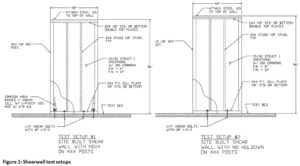
The top of wall was attached to the actuating ram using a steel channel and fastened to the double top plates with 3” SDS screws. The ram pushed and pulled the top of wall according to the CUREE test protocol.
No Holdown Wall:
A wall assembly without holdowns can only rely on the wood sill plate members, sill plate anchorage and sheathing to resist the overturning force. The two limit states commonly observed in the test: 1) The sheathing fasteners prying the sill plate in cross-grain tension. (see Figure 2) 2) Fastener tearing the sheathing at the sill plate. (see Figure 3) Little damage was observed between the sheathing and end post along the height of the post. Figure 4 is the load vs. displacement graph showing the peak load, 928 lbs., at relatively small displacement, 1.57”.
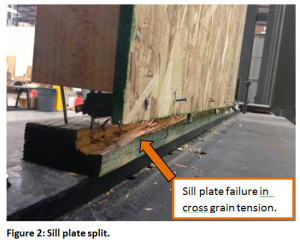
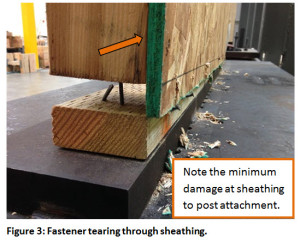
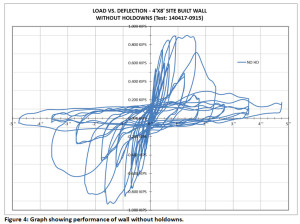
Wall With Holdown:
The change in restraining the end posts increases wall stiffness, capacity and ductility of the assembly. The peak load was 2,907 lbs. at a displacement of 2.3”. (see Figure 5) The use of a holdown to restrain the post and engage additional sheathing fasteners minimized cross-grain tension on the sill plate compared with the test without holdowns. (see Figure 6) The increase in both strength and ductility comes from the additional number of fasteners engaged along the height of the post when the post is restrained. (see Figure 7) The assembly with holdowns was able to achieve approximately three times more strength compared with the same amount of material used without holdowns. Ductility also increased substantially, which can be observed from illustrating the hysteresis curves of both tested assemblies for comparison. (see Figure 5)
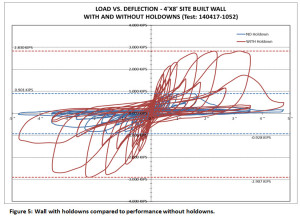
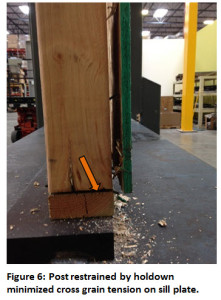
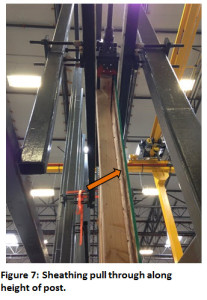
The comparison between the two walls is based on a 4 foot wide by 8 foot tall configuration. A wall with a different aspect ratio may change the performance, but walls with holdowns will achieve higher loads, and lower displacements, and more ductile performance.
What are your thoughts about shearwall assembly? Let us know in the comments below.


1 thought on “Use of Holdowns During Shearwall Assembly”
Comments are closed.